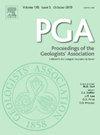英国下格林桑组Faringdon海绵砾石段和Atherfield粘土组海绵的修正
IF 1.2
4区 地球科学
Q2 Earth and Planetary Sciences
引用次数: 0
摘要
下格林森群(LGS)的海绵保存完好,出现在砂质基质的沉积物中。这些海绵,主要是Calcareans,在牛津郡被发现,在小考克斯威尔采石场有显著的保存。根据最新的海绵分类研究和最新的海绵分类研究,对常见物种进行了描述,并以伦敦自然历史博物馆(NHM)、英国地质调查局(BGS)和巴塞尔自然历史博物馆(NMB)的标本为例进行了说明。记录和描述了下列分类群:1)Calcareans;大腹棘腹螨(帕金森,1822),狭腹棘腹螨(Keeping, 1883),不规则棘腹螨(Hinde, 1884),粗腹棘腹螨(de Fromentel, 1861),法林顿棘腹螨(曼特尔,1854),曼特尔棘腹螨(Hinde, 1884),吉利棘腹螨(de Loriol, 1869),繁殖棘腹螨(Hinde, 1884),拉莫棘腹螨(Roemer, 1839),扩张眼海绵虫(Roemer, 1864), pulvinaria Tremospongia (Goldfuss, 1826),弯曲棘腹螨(Hinde, 1884),斑纹棘腹螨(Hinde, 1884),斑纹棘腹螨(Hinde, 1884),斑纹棘腹螨(Hinde, 1884),斑纹棘腹螨(Hinde, 1884),斑纹棘腹螨(Hinde, 1884)。1854年)、farringdonensis (Sharpe, 1854年)、Raphidonema macropora (Sharpe, 1854年)、Raphidonema pustulatum (Hinde, 1884年)、Endostoma foraminosa (Goldfuss, 1826年);2) Hexactinellids: Lonsda contortuplicata (Lonsdale, 1849)。主要发现包括鉴定特提斯生物地理亲和性和生态适应性,突出了这些海绵在早期礁状系统中的作用。通过完善物种描述并将其与更广泛的白垩纪生态系统联系起来,这项工作增强了对海绵生物多样性、进化策略及其在环境变化时期对碳酸盐台地发育的贡献的理解。本文章由计算机程序翻译,如有差异,请以英文原文为准。
A revision of sponges from the Faringdon Sponge Gravel Member and Atherfield Clay Formation, Lower Greensand Group of England
Sponges of the Lower Greensand Group (LGS) are well preserved and occur in sediments of a sandy matrix. Abundant in the Faringdon Sponge Gravel Member (FSG), these sponges, mostly Calcareans, are found in Oxfordshire, with notable preservation at Little Coxwell quarries. This study provides descriptions of common species following the updated Porifera classification and recent sponge taxonomy research, illustrated with specimens from the Natural History Museum, London (NHM), British Geological Survey (BGS), and Natural History Museum Basel (NMB) collections. The following taxa are recorded and described: 1) Calcareans: Barroisia anastomosans (Parkinson, 1822), Barroisia clavata (Keeping, 1883), Barroisia irregularis (Hinde, 1884), Dehukia crassa (de Fromentel, 1861), [Elasmoierea] faringdonensis (Mantell, 1854), [Elasmoierea] mantelli (Hinde, 1884), Peronidella gillieroni (de Loriol, 1869), Peronidella prolifera (Hinde, 1884), Peronidella ramosa (Roemer, 1839), Oculospongia dilatate (Roemer, 1864), Tremospongia pulvinaria (Goldfuss, 1826), Raphidonema contortum (Hinde, 1884), Raphidonema porcatum (Sharpe, 1854), Raphidonema farringdonensis (Sharpe, 1854), Raphidonema macropora (Sharpe, 1854), Raphidonema pustulatum (Hinde, 1884), Endostoma foraminosa (Goldfuss, 1826); and 2) Hexactinellids: Lonsda contortuplicata (Lonsdale, 1849). Key findings include the identification of Tethyan biogeographic affinities and ecological adaptations that highlight the role of these sponges in early reef-like systems. By refining species descriptions and linking them to broader Cretaceous ecosystems, this work enhances understanding of sponge biodiversity, evolutionary strategies, and their contributions to carbonate platform development during periods of environmental change.
求助全文
通过发布文献求助,成功后即可免费获取论文全文。
去求助
来源期刊
CiteScore
2.70
自引率
8.30%
发文量
54
审稿时长
6-12 weeks
期刊介绍:
The Proceedings of the Geologists'' Association is an international geoscience journal that was founded in 1859 and publishes research and review papers on all aspects of Earth Science. In particular, papers will focus on the geology of northwestern Europe and the Mediterranean, including both the onshore and offshore record. Following a long tradition, the PGA will focus on: i) a range of article types (see below) on topics of wide relevance to Earth Sciences ii) papers on aspects of Earth Science that have societal relevance including geoconservation and Earth management, iii) papers on palaeoenvironments and palaeontology of the Mesozoic and Cenozoic, iv) papers on aspects of Quaternary geology and climate change, and v) papers on the history of geology with particular reference to individuals that have shaped the subject. These topics will also steer the content of the themes of the Special Issues that are published in the PGA.

 求助内容:
求助内容: 应助结果提醒方式:
应助结果提醒方式:


